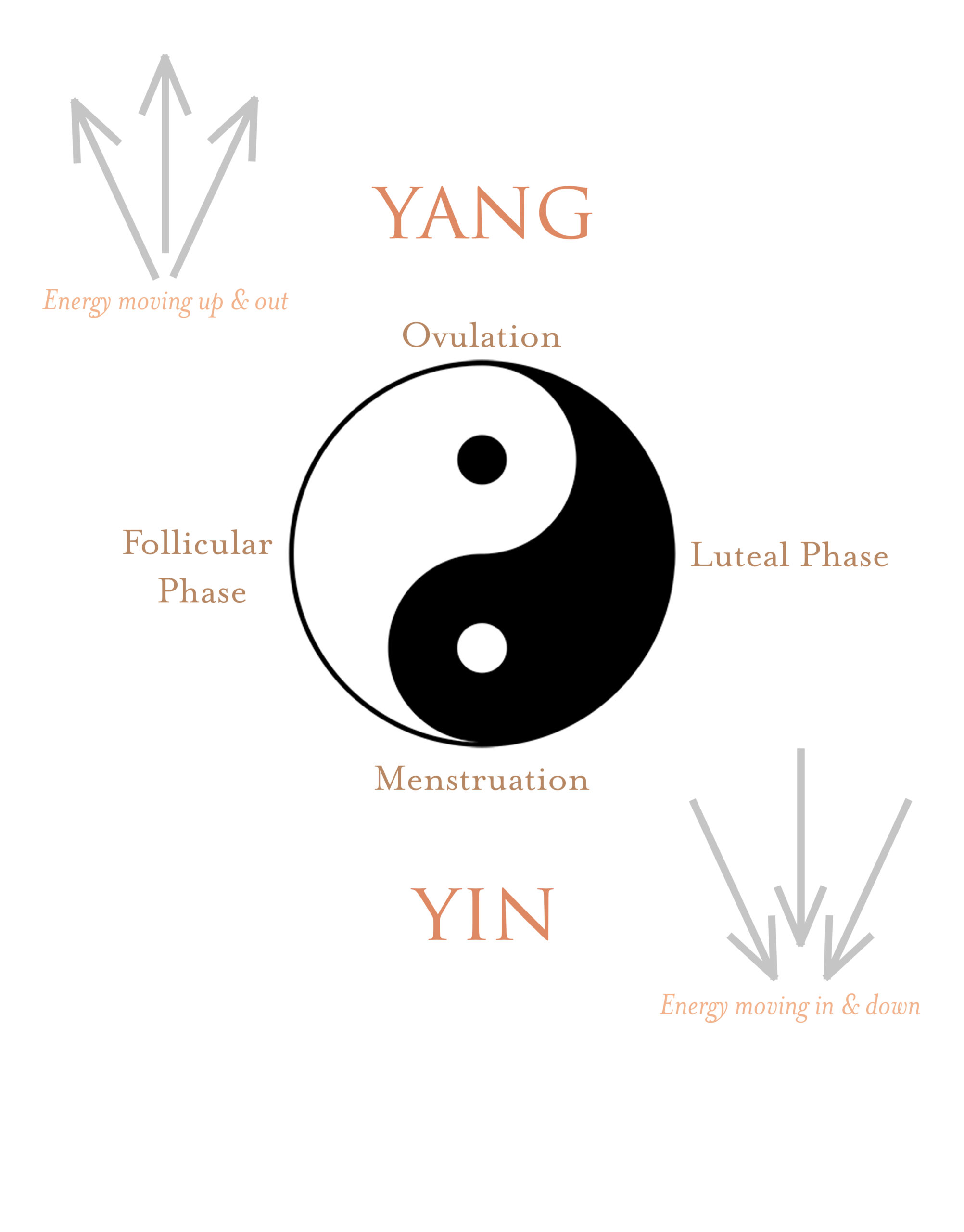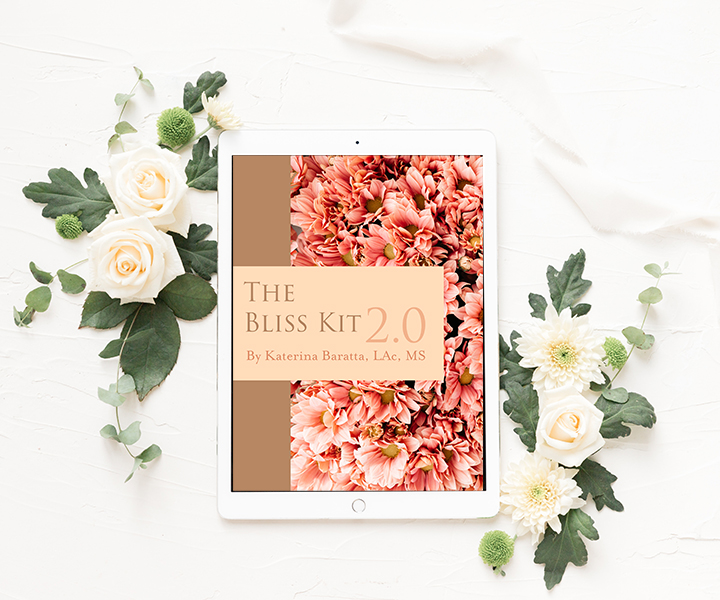How to Optimize Your Lifestyle for a Healthy Menstrual Cycle
Every person in a menstruating body knows what an impact their cycle can have on well-being.
One week you feel like you’re on top of the world, full of energy, ideas, and enthusiasm for life.
You make all sorts of plans, thinking a feeling this good has got to last.
But the next thing you know, your body hurts and feels heavy.
The smallest misstep feels like the biggest injustice, ever.
And then you find yourself balling over diaper commercials.
Forget the plans you were excited about, all you want to do now is stay under the blankets watching Emily in Paris, drinking tea all day.
What gives?
As any medical professional will tell you, a lot of this comes down to hormone flow.
(Check out the end of my article on hormones and anxiety for some suggestions on how to balance your hormones naturally).
But from a holistic standpoint it’s not just hormones that impact your well-being.
How you feel also comes down to how the life-force energy (sometimes called qi or prana) is flowing through your system, and your diet, lifestyle, and mindset can all impact the ability for this energy to flow.
We’re going to discuss all of it here.
First, we’re going to clarify what a healthy menstrual cycle looks like according to conventional and natural medicine (natural medicine’s concept of “healthy” is much more detailed).
We’ll get into the 4 phases of the menstrual cycle, fertility, and how hormones play into these phases.
We’ll also talk about energy flow throughout the menstrual cycle, how this flow impacts how you feel through each phase.
Then we’ll talk about imbalance.
You’ll get a comprehensive list of signs and symptoms to be on the lookout for that tell you something needs healing.
And finally, we’ll talk about specific lifestyle adjustments you can make to support optimal energy flow throughout your cycle.
Plus I’ll give you some suggestions on what to do if you’re dealing with uncomfortable menstrual symptoms and feel like something is off.
First up: What does a healthy menstrual cycle look like?
From a conventional medicine standpoint, a healthy menstrual cycle lasts anywhere from 21-35 or even 40 days. 1, 2
And it’s divided into 4 phases.
The first phase is the menstrual phase, which normally lasts about 2-7 days.
This is when the uterus sheds its lining so it can make a fresh start to prepare for potential pregnancy.
Days 6-14 (ish) comprise the second phase is the follicular phase.
The follicular phase is when the hormone estrogen rises and causes the lining of the uterus to thicken. Follicule-stimulating hormone (FSH) also rises toward the end of this phase to help fully mature an egg in the ovaries.
Ovulation is the midpoint of the menstrual cycle, when luteinizing hormone stimulates the ovaries to release the newly matured egg.
Testosterone also spikes around ovulation, increasing libido and muscle performance.
Ovulation is further characterized by discharge that is sticky, elastic, and resembles egg-whites, in order to support the passage of sperm to fertilize the egg.
Although ovulation only occurs on one day, because sperm can survive up to 5 days, you can still get pregnant if you have sex up to 5 days prior to ovulation or 1 day after ovulation. 3, 4
The luteal phase begins the day after ovulation and lasts until the start of the next menstrual phase, around days 15-28 of the menstrual cycle.
The luteal phase is characterized by a spike in the hormone progesterone, as well as a secondary increase in estrogen, to prepare the uterine lining for pregnancy.
Estrogen and progesterone drop again toward the end of the luteal phase, right before the next menstrual cycle begins, signaling the uterus to shed its lining.
That’s what’s happening from a biomedical standpoint, but what about the flow of energy during the menstrual cycle?
This is where understanding your cycle really gets fun.
Because natural medicine practitioners are much more specific about what it means to have a healthy menstrual cycle.
According to traditions like Ayurveda and Chinese medicine, the ideal menstrual cycle is correlated with the cycles of the moon, lasting 29.5 days.
The healthiest flow will start right around the new moon when yin energy is at its peak, and ovulation will happen during the full moon when there is abundant up-and-out yang energy.
Healthy menstrual blood is bright red and fluid, with few or no clots.
Blood should not smell foul or fishy, though it may have a metallic or sweet tinge to it, and should not stain clothing.
You may feel a downward tug in your abdomen during healthy menstruation, but there shouldn’t be any pain or cramping (we’ll talk more about imbalance and what to do about it later).
Anything else is considered a red flag that there’s an underlying imbalance at play.
But one thing that’s perfectly normal is that your energy levels fluctuate during a healthy menstrual cycle.
Yin energy moves in and down, making you feel more mellow and introverted toward the end of the luteal phase and into the menstrual phase.
Yang’s up and out energy starts building up during menstruation and peaks at ovulation, which is why you feel tend to feel most energized and outwardly focused in the middle of your cycle.
Honor those feelings and follow your body’s cues!
Your feelings of laziness or restlessness or whatever is coming up for you are there for a reason.

Let’s take this concept a little deeper.
Menstrual Phase Energy
Menstruation is when your body is shedding what is no longer needed.
Accordingly, if there are emotional, mindset, or behavioral patterns that don’t serve you, your menstrual phase is one of the best times to work on letting them go.
Your intuition is strongest during the menstrual phase, and restlessness, anxiety, and dissatisfaction are signs that something in your environment or mindset needs extra attention.
Pay attention to your feelings and try to listen into the wisdom underneath your fears so you can course-correct as needed.
(If you want some guidance, watch the free Decoding Anxiety Masterclass to learn more about what your feelings are trying to tell you.)
In practicing this, remember, your intuition feels open, expansive, secure, unwavering, and grounded.
Fear and anxiety feel closed, questioning, unsure, tight, stressed, and constricted.
Follicular Phase Energy
Just as the moon waxes and becomes more full, energy levels in you also begin to rise as you approach ovulation.
The follicular phase is full of spring-like energy.
It’s when you blossom.
This is when creativity peaks, and it’s the best time of the month to daydream, make plans, and organize your life.
Ovulation Phase Energy
Ovulation is the midpoint of your cycle when yang’s up-and-out energy is at its max.
This phase is all about connection and communication.
If there are important conversations or events that need to happen, try to have them during ovulation.
Planning a party? Schedule it for when you’re ovulating if you can.
Want to ask for a raise? Do it during ovulation.
You will be at your most charming and communicate with the most clarity during this time, so take advantage of the energy and put yourself out there during this time.
Luteal Phase Energy
Energy starts to move back in and down right after ovulation, and continues its decent throughout the luteal phase.
As a result, you might notice your energy is still high right after ovulation (just like summer energy that continues after solstice).
But then it dips down to its lowest point during the second half of the luteal phase, right before menstruation.
Again, honor what your body is telling you!
Because while some PMS symptoms arise from deeper forms of imbalance, many symptoms like exhaustion, overwhelm, and anxiety are made worse by trying to push through and force energy to move up when it’s moving down.
Activities can still be full of energy and sociability during the 5-7 days after ovulation.
But the best activities to support the second half of your luteal phase are mellower, because you’re heading into the phase of the month when energy is at its lowest.
These are the ideal scenarios.
But they’re not most people’s reality, mainly because most of us simply aren’t taught how to adjust our lifestyles to support a healthy menstrual cycle.
We’ve been taught to focus more on the knowledge of the mind instead of the inherent wisdom of our bodies.
And we’ve been conditioned to conform our needs into the static, 24/7 schedule that was designed for and by biologically male bodied people.
This disconnection from our bodies and the natural flow of energy throughout the month can lead to some very uncomfortable and often serious consequences for menstruating bodies.
Because when you live in a way that is out of sync with your menstrual cycle, it’s like you’re paddling upstream all the time instead of letting the flow of life energize and support you.
And over time, it can deplete your inner resources and cause stagnation which leads to laundry list of signs and symptoms.
People with bodies that menstruate are really lucky, because it’s such a clear indication of how vital energy is flowing in the body.
And there are many ways in which that energy flow can get imbalanced, which impacts all of the systems within the body.
When I work with patients 1-on-1, I take an extensive health and personal history to identify their mind & body’s dominant patterns.
This includes not just menstrual symptoms but also details about their digestion, sleep, emotions, skin, physical pain, and more, because all of these signs and symptoms together point to the underlying issues.
When you look at your menstrual cycle, it’s important to remember that while menstrual symptoms are incredibly common, that doesn’t mean they’re healthy.
It’s also important to acknowledge that while conventional practitioners have extensive training in biomedical diagnostics and treatment, most have little to no training when it comes to root-cause healing and energy medicine.
This means that even when all of your labs come back normal and your doctor says there’s “nothing wrong” with you, there can still be an underlying imbalance that needs to be addressed.
Just because medical doctors don’t recognize or know how to treat these issues doesn’t mean they aren’t important.
They’re very important.
You know how much they impact you and your ability to show up for life the way you want to.
And if something isn’t flowing optimally in your life, it’s your right to figure out what’s going on in your body and to take action to correct it.
Symptoms that arise and subside at the same time every month are almost always related to the energy fluctuations in the menstrual cycle.
But all uncomfortable symptoms point to imbalance, so don’t dismiss them just because the timing doesn’t correlate perfectly with your menstrual phases.
Timing is just another sign, but it’s not the whole picture.
The whole picture is all of your signs and symptoms put together.
Here are the most common menstruation-related signs and symptoms to be on the lookout for:
Pain & cramping
Headaches
Muscle heaviness
Stiffness
Breast tenderness
Low libido
Night sweating
Exhaustion
Insomnia
Bloating
Nausea
Vomiting
Diarrhea or constipation
Excessive discharge between periods (to the point where you need a pantyliner)
Yeast infections
Acne
Itchiness
Dry lips
Anger and irritability
Anxiety, nervousness, fear
Restlessness
Depression
Emotional eating
Unpredictable menstruation
Spotting
Excessively light or heavy flow
Brown, dark, yellowish, or purple blood
Clots, especially bigger than a quarter
Sticky blood
Blood that has a strong foul odor
Blood that stains clothing
How to keep your system balanced:
This list is looooong.
And different combinations of symptoms point to different underlying patterns of imbalance.
Clearly, we don’t have time to go through all of the potential imbalances and how to treat them here.
But the wonderful thing is, your system can often be brought back to equilibrium by making simple lifestyle adjustments throughout your cycle.
The first thing to do is to start paying attention.
Track your symptoms, read your body, and know what phase of the menstrual cycle you’re in.
And once you know which phase you’re in, adjust your activity level accordingly.
Here are some suggestions:
Activities that support the flow of energy during the menstrual phase include:
Meditating
Reading
Journaling
Self-inquiry
Gentle yoga or qigong
Walking outside
Gardening
Spending time with nature
Alone-time
Activities that support the flow of energy during the follicular phase include:
Cleaning
Creative projects
Problem solving
Social activities
Pranayama/breathing practices
Vinyasa, ashtanga, or power yoga
Cardio and strength training
Group classes
Activities that support your energy during ovulation (and the beginning of the luteal phase) include:
High intensity exercise
Dancing
Deep conversation
Group projects
Dates (with anyone!)
Hula-hooping
Playing games
Activities that best support you during the (second half of) luteal phase include:
Self-inquiry
Moving meditation and qigong
Practice letting go & surrender
Attending to details and loose ends
Attention to beauty and aesthetics
Self-care and pampering
Walking
Pilates
Finally, if you have symptoms of imbalance and your doctor’s not giving you any real answers, I highly encourage you to get the support of a holistically trained practitioner.
And if emotional symptoms are part of that picture, we should chat.
Because helping female-bodied people enjoy a healthier menstrual cycle is just one aspect of the work I do.
What’s happening with your menstrual cycle is an indication of what’s happening in your whole mind-body-spirit system.
And I specialize in helping people identify and heal the root causes of stress and anxiety holistically, using mind, body, and spirit medicine.
There are many, many, many natural strategies you can use than I’ve listed here.
These include dietary shifts, herbal medicine, acupressure/moxibustion, and more.
And these strategies are always most effective when customized to your unique pattern of imbalance.
I’d love to help you figure out what’ll work best for you.
Click here if you’d like to learn more.
I can’t wait to see where this takes you!





